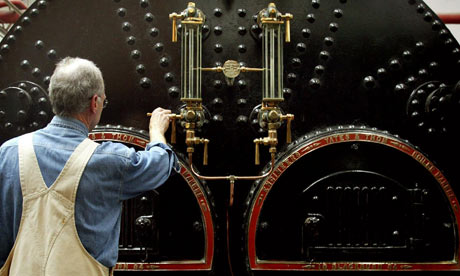
While fans of speculative fiction are not known for their adherence to high fashion, the genre produces no end of trends to follow. In recent years paranormal romance has put vampires back on the catwalk, posthumanism has been inspiring the look of science fiction for some time and the New Weird is still the new black in fantasy. But of all speculative fiction's sub-genres, steampunk is proving to be among the most popular and influential.
Take the steam-driven Industrial Revolution of the 18th century, pair it with the information revolution of the 20th and accessorise with the nihilistic political outlook of punk and youth culture, and the resulting outfit is steampunk. In the genre's best known and most imitated work, The Difference Engine, science fiction heavy hitters William Gibson and Bruce Sterling, not satisfied with setting the pace for the cyberpunk movement, turned their talents to alternative history, and steampunk was born. The Difference Engine charts an alternative Britain where Charles Babbage succeeded in his ambition to perfect a mechanical computer, leading to an all-powerful British empire based on steam-driven information technology. But beneath its Victoriana stylings, Gibson and Sterling crafted a fascinating speculation on the workings of western society and politics.
The success of the The Difference Engine put steampunk on the map, and several of genre fiction's biggest beasts – including Michael Moorcock, Neal Stephenson and Michael Chabon – have turned their hand to it. But the real voices putting the punk into steampunk are as yet little known beyond the realm of speculative fiction. Much of the best work in the genre has happened in the pages of speculative fiction magazines such as Asimov's or been published by independent presses. More accessibly, Anne and Jeff VanderMeer have gathered many of the gnarliest examples of the genre in their Steampunk anthology.
This anthology gives us Moorcock, Stephenson and Chabon, but it's also worth reading for Ted Chiang. Acclaimed as a master of the short form, he has written fewer than a dozen stories in a career spanning almost two decades, but they have won every major award in the field, including the Hugo and Nebula. Steampunk gives us Seventy-Two Letters, a piercing look at the corruption that accompanies scientific research and the ways technology oppresses the underclass in society. That it does this through the metaphor of automata driven by Kabbalistic magic whilst telling a perfectly crafted short story is trademark Chiang. In contrast, Jay Lake is among the most prolific authors of short fiction in recent years. His contribution to the collection, The God-Clown is Near, centres on the character of Dr Cosimo Ferrante, a "flesh sculptor" who finds himself embroiled in a revolutionary plot against society. Lake's work is filled with so many intense and detailed characters that it's easy to overlook the ideas in his work, but here he manages a sharp insight into the political innards of steampunk. Meanwhile, the British writer Ian R MacLeod brings an anti-capitalist perspective to the steampunk discussion, with The Giving Mouth, a story that blends industrial grit with the essence of magic in a style reminiscent of his excellent novel The Light Ages.
As with any literary movement, steampunk has spawned its share of second-rate imitators who miss the meaning beneath the genre's surface. Writers can get away with playing with the trappings of Victoriana without having any real insight into the history they're tinkering with, and readers can wallow in the tight corsets and even tighter trousers of an array of Buchanesque caricatures without ever having to engage the old grey matter. But at its best, steampunk allows writers such as Chiang, Lake and MacLeod to fuse complex social and political ideas with the wild and chaotic imagination that gives speculative fiction its energy.

